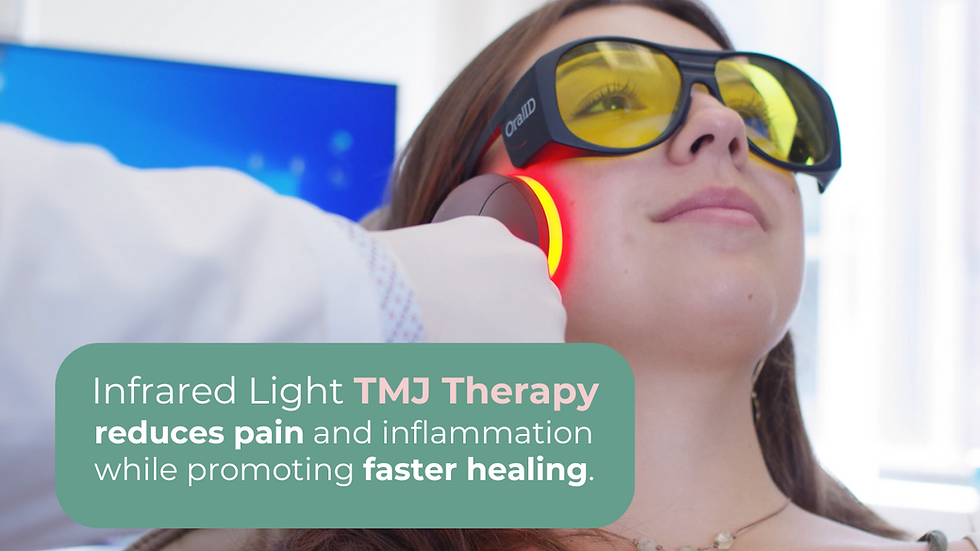Bite Misalignment and TMJ: What's the Connection?
- Marc Lazare

- Aug 12, 2024
- 3 min read
Bite misalignment, also known as malocclusion, is a common dental issue that affects many people. While it may seem like a minor inconvenience, bite misalignment can have significant repercussions on your overall oral health, particularly in relation to your temporomandibular joint (TMJ). Understanding the connection between bite misalignment and TMJ disorders is crucial in addressing both the symptoms and underlying causes of these conditions.

What is Bite Misalignment?
Bite misalignment occurs when the upper and lower teeth do not come together properly when the jaw is closed. This can manifest in various forms, such as overbite, underbite, crossbite, or open bite. While some people may experience only mild misalignment, others might have more severe cases that can lead to discomfort and other dental issues.
Understanding the Temporomandibular Joint (TMJ)
The temporomandibular joint (TMJ) is the hinge that connects your jawbone to your skull. It allows you to perform essential functions such as chewing, speaking, and yawning. The TMJ is a complex and delicate structure, and any issues affecting it can result in a range of symptoms known as temporomandibular joint disorder (TMD).
The Connection Between Bite Misalignment and TMJ
Bite misalignment can directly impact the TMJ by placing undue stress on the joint and surrounding muscles. When the teeth do not align properly, the jaw has to work harder to perform its usual functions, leading to strain and discomfort in the TMJ. Over time, this strain can result in TMD, which is often characterized by symptoms such as:
Jaw Pain: One of the most common symptoms of TMD is pain in the jaw, which can range from mild discomfort to severe, debilitating pain. This pain may be localized to the TMJ or spread to other areas, such as the neck, shoulders, and ears.
Clicking or Popping Sounds: Many people with TMD report hearing clicking or popping sounds when they open or close their mouth. These sounds are often a sign that the TMJ is not functioning correctly.
Difficulty Chewing: Bite misalignment can make it challenging to chew food properly, leading to discomfort and pain. Over time, this can exacerbate TMJ issues and contribute to the development of TMD.
Headaches: TMD is often associated with chronic headaches, particularly in the temples. These headaches are typically the result of muscle tension caused by the jaw's misalignment.
Addressing Bite Misalignment and TMJ Disorders
If you suspect that bite misalignment may be contributing to TMJ issues, it is essential to seek professional dental care. A dentist can assess your bite and determine the best course of action to address the problem. Some potential treatments for bite misalignment and TMD include:
Orthodontic Treatment: Braces or clear aligners can help correct bite misalignment by gradually moving the teeth into their proper positions. This can alleviate the stress on the TMJ and reduce TMD symptoms.
Nightguards: For those who grind their teeth or clench their jaw at night, a custom-made nightguard can help protect the teeth and relieve pressure on the TMJ.
Restorative Dentistry: In some cases, dental restorations such as crowns, bridges, or veneers may be necessary to correct bite misalignment and improve the function of the teeth and jaw.
Physical Therapy: Exercises and stretches designed to strengthen the jaw muscles and improve flexibility can be beneficial for those with TMD. A physical therapist can work with you to develop a personalized treatment plan.
Lifestyle Modifications: Reducing stress, avoiding hard or chewy foods, and practicing good posture can all help alleviate TMJ symptoms and prevent further damage to the joint.
Bite misalignment and TMJ disorders are closely connected, and addressing one often involves treating the other. If you are experiencing symptoms of TMD or are concerned about your bite alignment, it is essential to consult with a dental professional who can provide an accurate diagnosis and develop a tailored treatment plan. By taking proactive steps to address bite misalignment, you can reduce the risk of developing TMJ disorders and enjoy improved oral health and overall well-being.



